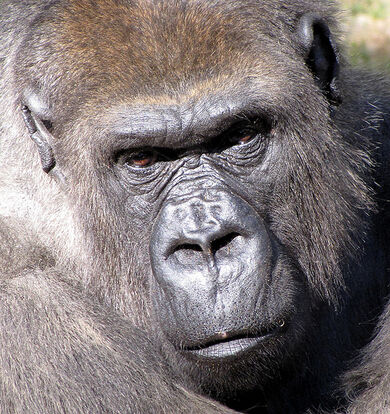No edit summary Tag: sourceedit |
No edit summary Tag: sourceedit |
||
| Line 37: | Line 37: | ||
'''References''' |
'''References''' |
||
<references/> |
<references/> |
||
| + | [[Category:Primate conservation]] |
||
[[Category:Biodiversity]] |
[[Category:Biodiversity]] |
||
[[Category:Sustpedia]] |
[[Category:Sustpedia]] |
||
Latest revision as of 19:35, 28 August 2015

The main threats to gorillas are hunting for food and traditional medicine, destruction of habitat through logging, mining and unsustainable production of charcoal, as well as the effects of armed conflicts and diseases like Ebola. Concerted conservation and restoration efforts focus on saving gorilla populations in the wild and their habitats. However, gorillas remain on the brink of extinction, and continue to face severe threats.
In 2006, the Convention on Migratory Species (CMS) requested the Royal Belgian Institute for Natural Sciences, in partnership with the Great Apes Survival Partnership (GRASP), and in consultation with the gorilla range states and GRASP members, to develop a gorilla conservation agreement, to be implemented via a regional, transborder Action Plan.
The agreement, which came into effect in June 2008 and has so far been signed by six of the ten gorilla range states, provides a legal framework that will reinforce and integrate conservation efforts. Supporting the implementation of the Gorilla Agreement is the overarching goal of the Year of the Gorilla 2009. [1]
Gorillas, their habitats, and the ever-growing human demand for energy
An omnipresent yet invisible threat to gorillas and their habitats, as well as to countless other species, is the ever-growing human demand for energy and its consequences.
Charcoal production is a major threat to gorilla forests in many areas, not least the Mountain Gorilla habitat in Virunga National Park, Democratic Republic of Congo. To reduce this threat, solar cookers, tree-planting on farms and the spread of fuel-efficient stoves are needed. The Year of the Gorilla (YoG) is supporting a project in the Mountain Gorillas' range which enables local residents to purchase highly fuel-efficient stoves for a low price, thereby enabling them to use less firewood, which is often taken from the very same forests that are home to the gorillas.
This threat manifests itself also through fossil fuel extraction. Oil exploration in Petit Loango wetland, Gabon, put Western Lowland Gorillas in peril, but prospecting luckily did not yield results to justify further action. The search for nuclear fuel can have similar effects.
Robert Hepworth, Executive Secretary of the Convention on the Conservation of Migratory Species of wild animals (UNEP/CMS): "Stopping the current overexploitation of natural resources is a key element of any strategy leading to a sustainable way of living. The forests and woodlands of Africa must play a central role in efforts to avoid dangerous climate change. There is a strong scientific case for carbon finance to make significant contributions to gorilla conservation, as gorilla range states would benefit financially from protecting their forests."
A further worrying development is the fact that many gorilla range states are signing land deals with foreign companies for agriculture, including biofuels. On top of destroying the habitat of numerous species, forest degradation also means palm oil, an edible oil found in one in ten supermarket products and also increasingly being seen as a profitable bio-fuel, has a higher carbon footprint than the fossil fuels it is supposed to replace.
Beyond the immediate impact of these industries, the influx of relatively well-paid workers who can afford to frequently eat meat causes bushmeat trade to boom and gorillas to decline, as happened with the Coltan boom in Democratic Republic of Congo in 2000/2001.
Keystone species and climate change: "Save the gorillas and you save the world!"
Apes and other large mammals are keystone species in their ecosystems, dispersing billions of seeds, which have higher germination and seedling survival rates than seeds that just fall to ground. Ian Redmond OBE, Ambassador for the YoG, "I am proud to be an Ambassador for the YoG. Fascinating though gorillas are because of their similarities to humans, we also need to focus on their key ecological role. They are second only to elephants in the number of seeds dispersed per unit area, and symbolise the fate of the Congo Basin forests, which the planet needs for climate stability. Save the gorillas and you save the world!"
Viewed globally, degradation and destruction of habitats not only threaten gorillas, they also worsen climate change overall. Tropical trees in undisturbed forest are absorbing nearly a fifth of the CO2 released by burning fossil fuels. The world's remaining tropical forests remove 4.8 billion tonnes of CO2 emissions from the atmosphere each year. This includes a previously unknown carbon sink in Africa, mopping up 1.2 billion tonnes of CO2.
Year of the Gorilla
Numerous threats endanger gorillas' survival. Together with the other great apes, they are most severely threatened by: habitat loss and fragmentation; hunting and the bushmeat trade; diseases and epidemics; mining; and the effects of armed conflicts. This is why the Convention on the Conservation of Migratory Species (UNEP/CMS), the UNEP/UNESCO Great Apes Survival Partnership (GRASP) and the World Association of Zoos and Aquariums (WAZA) have joined forces to declare 2009 the Year of the Gorilla.
Angela Meder of the German gorilla conservation NGO Berggorilla & Regenwald Direkthilfe e.V.: "This year, we celebrate our 25th anniversary. Our organization supports gorilla conservation projects through quick, unbureaucratic help. For example we are currently supporting the reforestation of a montane forest on the edge of Virunga National Park in the Democratic Republic of Congo."
Related topics
References
- ↑ United Nations Environment Programme, May 22, 2009